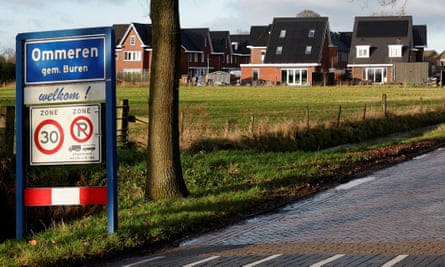As the Nazis fled occupied Europe in the final days of the second world war, four German soldiers buried a hoard of gold coins and jewels in the middle of nowhere in the Dutch countryside. Nearly 80 years later, hopes of finding the buried loot have been raised after the National Archives of the Netherlands released a trove of documents – and a map to the treasure where X marks the spot.
The treasure – four ammunition cases laden with coins, watches, jewellery, diamonds and other gemstones – is thought to have been worth at least 2m or 3m Dutch guilder in 1945, the equivalent of around £15.85m in today’s money.
“A lot of researchers, journalists and amateur archaeologists are really interested and excited,” said Annet Waalkens, an adviser at the National Archives, which last week released more than 1,300 historical documents. Whether any would-be treasure hunter will be able to find the cases is another matter. Among the cache of second world war papers was a 7cm-thick file that recounted the fruitless efforts of the Dutch state to find the looted Nazi treasure after the war.
Researchers believe the treasure was buried in April 1945, when the Allies were on the brink of liberating Arnhem in the eastern Netherlands. German soldiers were fleeing. “They decide to bury the treasure, because it’s just getting a bit too hot under their feet and they’re getting scared,” Waalkens told the Observer.
The precious cargo was buried in the roots of a poplar tree, 70-80cm deep, just outside the village of Ommeren, around 25 miles from Arnhem. The riches might have vanished from the historical record for ever were it not for a chatty German soldier, Helmut S, who was not one of the original looters but took part in the burial.
The National Archives are withholding his full name, as Helmut S, born in 1925, may still be alive, although no one has been able to trace him. Of the three other soldiers, two did not survive the war and the other simply vanished.
Helmut S, however, stayed on the radar. “He was a bit loose-lipped back in Berlin,” said Waalkens, and he soon came to the attention of Dutch authorities in the occupied German city. They passed the information on to the Beheersinstituut, the Dutch Institute of Asset and Property Management, a body responsible for managing the wealth of people who had disappeared in the second world war, including deported Jews, Dutch spies and German citizens who lived in the Netherlands.
According to Helmut S, the hoard was discovered when an Arnhem branch of the Rotterdamsche bank was bombed in August 1944. A safe was smashed, leaving jewels, coins and other riches scattered in the street. His comrades pocketed what they could see, later hiding the loot in zinc ammunition boxes.
In 1946-47 the Beheersinstitut carried out three searches. The first failed because the ground was frozen. The second, aided by primitive metal detectors of the time, yielded nothing. For the third attempt they summoned Helmut S back from Germany to help, but despite his eyewitness knowledge and the map he had provided, the dig was fruitless.
Archivists are not certain who made the map but believe it was done by one of the German soldiers. After Helmut S handed it over, the map went into the file of the Beheersinstituut, with the proviso it would not be released for many years to protect the financial interests of the property owners.
![Old postcard of people watching German soldiers walking on a road in Holland in 1945 that was captioned ‘Departure of the Herrenvolk [master race]’](https://i.guim.co.uk/img/media/d7435dadd5e9c7b33354ab4beec993369a587c32/7_0_5366_3220/master/5366.jpg?width=445&quality=85&dpr=1&s=none)
Dutch officials toyed with several theories. Perhaps the treasure had been dug up by a local who witnessed the burial or by the mystery surviving German soldier. Others suspected the Americans. During the third dig, Beheersinstituut staff encountered two American officers and noticed that the soil in the area had been disturbed. “And they actually go to them and they say; ‘Well, we don’t know what you’re doing, but please mind your business and this is our affair,’” recounts Waalkens.

Joost Rosendaal, an assistant professor in history at Radboud university in Nijmegen, told the Observer that looting was common on both sides. In October 1944 at least five banks in Arnhem were looted by German soldiers. After the liberation in April 1945, another was robbed by troops in British uniforms, a group that included one Dutchman serving in the South Wales Borderers.
The historian thinks Helmut S got some of the facts wrong. Helmut’s version that his comrades stumbled across the jewels in the street after a bank was hit in August 1944 “can’t be true” because Arnhem was not bombed in that month, Rosendaal said.
It was not until September that the Allies attempted to take Arnhem, in the disastrous Operation Market Garden. This reckless gamble by Field Marshal Bernard Montgomery to break through to Germany cost many lives and was later dramatised in the 1977 film A Bridge Too Far.
Rosendaal thinks it likely the other soldiers stole the jewels in November 1944 when German forces set fire to Arnhem’s Rotterdamsche bank, with the blaze intended to “hide the robbing of the bank”.
The historian doubts the treasure will ever be found. The area around Ommeren was heavily bombed on the night of 24 April 1945 by the Royal Air Force. He suspects the hiding place was “destroyed by this bombardment”, allowing the treasure to be discovered by locals or Allied troops, or it was taken to another location by the Germans.
The Dutch archive team is more hopeful now the map is online and available to view in person at the Hague, alongside other papers from its 142km-long collection, which would stretch for 142km if lined up in a row. “I really hope that it is still there,” Waalkens said. “And that when it’s dug out perhaps we could trace some of the rightful owners.”